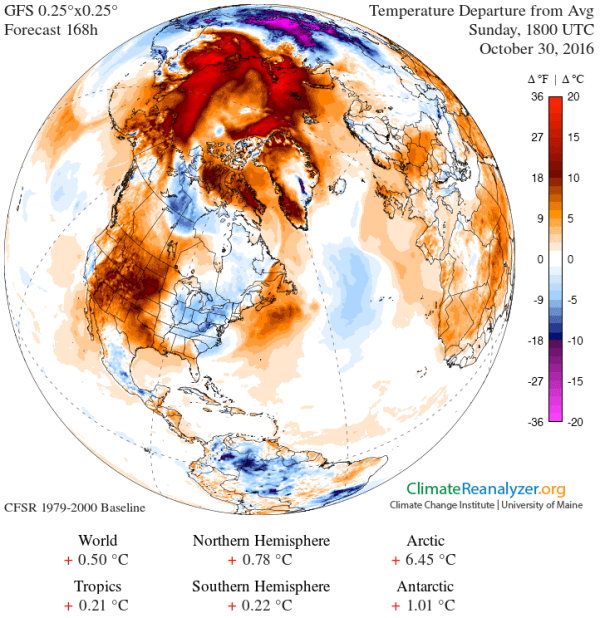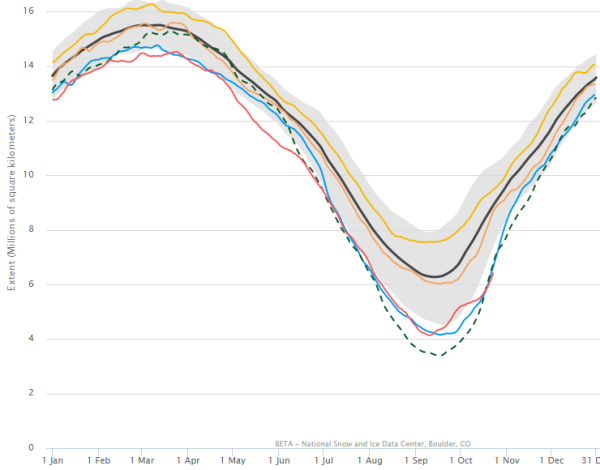You will notice that I am posting far less frequently on climate change. That is because I regard the evidence as well-and-truly in as to where we are headed. All we can do is to chronicle the Full Catastrophe
Global Warming is Winning the Battle Against Arctic Sea Ice — Extent Drops to New Record Lows
24
October, 2016
Ever
since human-forced climate change started to kick off dramatically
worsening polar warming events in the 2000s, the Arctic has struggled
to cool down to normal temperatures during fall and winter. However,
for 2016, this failure of Arctic cooling appears to have grown even
more pronounced.
Over
the past few weeks, temperature anomalies for the entire region north
of the 66th parallel have ranged between 3 and 5 degrees Celsius
above average. These are very extreme departures — ones we
typically have only seen during winter when the poleward heat energy
transfer effects of human-caused climate change are at their
strongest. But this fall, high
local ocean temperatures have
combined with a north-bound flood of warmth to turn the Arctic into a
glaring global hot spot — featuring
the highest above normal temperature readings for any region of
the Earth.
New
Record Daily Lows for Arctic Sea Ice
So
much added heat has had a marked effect on sea ice. Last week, Arctic
sea ice again dipped into record low ranges. Edging sideways away
from the usual rapid refreeze trend line, by today these record low
readings have become rather prominent in measures like
those produced by the National Snow and Ice Data Center (NSIDC).
(On
October 23rd, 2016, Arctic sea ice hit a new record daily low extent
of 6,434,000 square kilometers [pink line]. This beat out 2007’s
previous record of 6,501,000 square kilometers [blue line] and is now
trailing 2012’s October 23 measure of 6,785,000 square kilometers
[dashed green line] by a substantial margin. 2016’s
record low readings are now about 3 million square kilometers below
same day readings for October 23 of 1981 [light
orange line at top]. In other words, an area of sea ice approximately
the size of one and a half Greenlands has disappeared over the
intervening 35 year period. Image source: NSIDC.)
As
a result, sea ice extents are today ranging fully 3 million square
kilometers below levels seen during the early 1980s. In other words,
an area approximately one and one half times the size of Greenland
has been lost over the last 35 years.
Arctic
Temperature Anomalies to Worsen over the Coming Week
The
anomalous heat build-up in the Arctic pushing sea ice levels to new
all-time record low daily ranges is, unfortunately, expected to
worsen over the coming week. Today’s beyond-normal temperature
departures of around 4.35 degrees Celsius above average are
predicted by GFS models to
rise to around 6.45 C above average by Sunday.
These
high temperature readings are expected to concentrate in regions near
the sea ice edge. And so much heat focusing exactly in the region
where sea ice is attempting to expand risks a continued lagging of
seasonal ice accumulation. 15-20 C above average temperatures are
predicted to stretch from the Beaufort through the Chukchi, into the
East Siberian Sea, on through the Kara, down along the Northern Edge
of the Barents and into an Arctic Ocean zone just north of Greenland.
(We’re
currently witnessing a level of heat transfer into the Arctic that is
probably unprecedented. So much heat heading north and building up at
the pole due to local and global greenhouse gas buildup, ocean
warming, loss of summer reflectivity, and increasingly powerful
atmospheric gravity waves is now pushing Arctic sea ice into record
low daily ranges. As October shifts toward November, this Arctic heat
is likely to begin to produce some severe late fall and early winter
weather conditions. In the above map, we begin to see a signature hot
west, cool east dipole over the US. During past years, polar
amplification has helped to generate this extreme weather pattern in
the US where heat and drought is prevalent in the west while severe
winter weather dominates the east. Image source: Climate
Reanalyzer.)
You
can see these extraordinary predicted temperature anomalies in the
form of a spiky red swirl surrounding the Central Arctic in the GFS
temperature anomaly map provided by Climate Reanalyzer above. So much
heat at the ice edge reveals a big battle taking place between
powerful oceanic and atmospheric heat transfers into the Arctic and a
seasonal sea ice expansion that is fading in the face of a
human-forced warming of the world.
Links:
Scientific
Hat tip to Dr. Jennifer Francis
Hat
tip to Leslie Graham
Hat
tip to Marcel Guldemond


No comments:
Post a Comment
Note: only a member of this blog may post a comment.